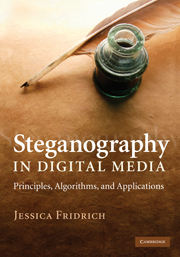Book contents
- Frontmatter
- Dedication
- Contents
- Preface
- Acknowledgments
- 1 Introduction
- 2 Digital image formats
- 3 Digital image acquisition
- 4 Steganographic channel
- 5 Naive steganography
- 6 Steganographic security
- 7 Practical steganographic methods
- 8 Matrix embedding
- 9 Non-shared selection channel
- 10 Steganalysis
- 11 Selected targeted attacks
- 12 Blind steganalysis
- 13 Steganographic capacity
- A Statistics
- B Information theory
- C Linear codes
- D Signal detection and estimation
- E Support vector machines
- Notation and symbols
- Glossary
- References
- Index
- Plate section
10 - Steganalysis
Published online by Cambridge University Press: 05 April 2014
- Frontmatter
- Dedication
- Contents
- Preface
- Acknowledgments
- 1 Introduction
- 2 Digital image formats
- 3 Digital image acquisition
- 4 Steganographic channel
- 5 Naive steganography
- 6 Steganographic security
- 7 Practical steganographic methods
- 8 Matrix embedding
- 9 Non-shared selection channel
- 10 Steganalysis
- 11 Selected targeted attacks
- 12 Blind steganalysis
- 13 Steganographic capacity
- A Statistics
- B Information theory
- C Linear codes
- D Signal detection and estimation
- E Support vector machines
- Notation and symbols
- Glossary
- References
- Index
- Plate section
Summary
In the prisoners' problem, Alice and Bob are allowed to communicate but all messages they exchange are closely monitored by warden Eve looking for traces of secret data that may be hidden in the objects that Alice and Bob exchange. Eve's activity is called steganalysis and it is a complementary task to steganography. In theory, the steganalyst is successful in attacking the steganographic channel (i.e., the steganography has been broken) if she can distinguish between cover and stego objects with probability better than random guessing. Note that, in contrast to cryptanalysis, it is not necessary to be able to read the secret message to break a steganographic system. The important task of extracting the secret message from an image once it is known to contain secretly embedded data belongs to forensic steganalysis.
In Section 10.1, we take a look at various aspects of Eve's job depending on her knowledge about the steganographic channel. Then, in Section 10.2 we formulate steganalysis as a problem in statistical signal detection. If Eve knows the steganographic algorithm, she can accordingly target her activity to the specific stegosystem, in which case we speak of targeted steganalysis (Section 10.3). On the other hand, if Eve has no knowledge about the stegosystem the prisoners may be using, she is facing the significantly more difficult problem of blind steganalysis detailed in Section 10.4 and Chapter 12. She now has to be ready to discover traces of an arbitrary stegosystem. Both targeted and blind steganalysis work with one or more numerical features extracted from images and then classify them into two categories – cover and stego.
- Type
- Chapter
- Information
- Steganography in Digital MediaPrinciples, Algorithms, and Applications, pp. 193 - 220Publisher: Cambridge University PressPrint publication year: 2009



